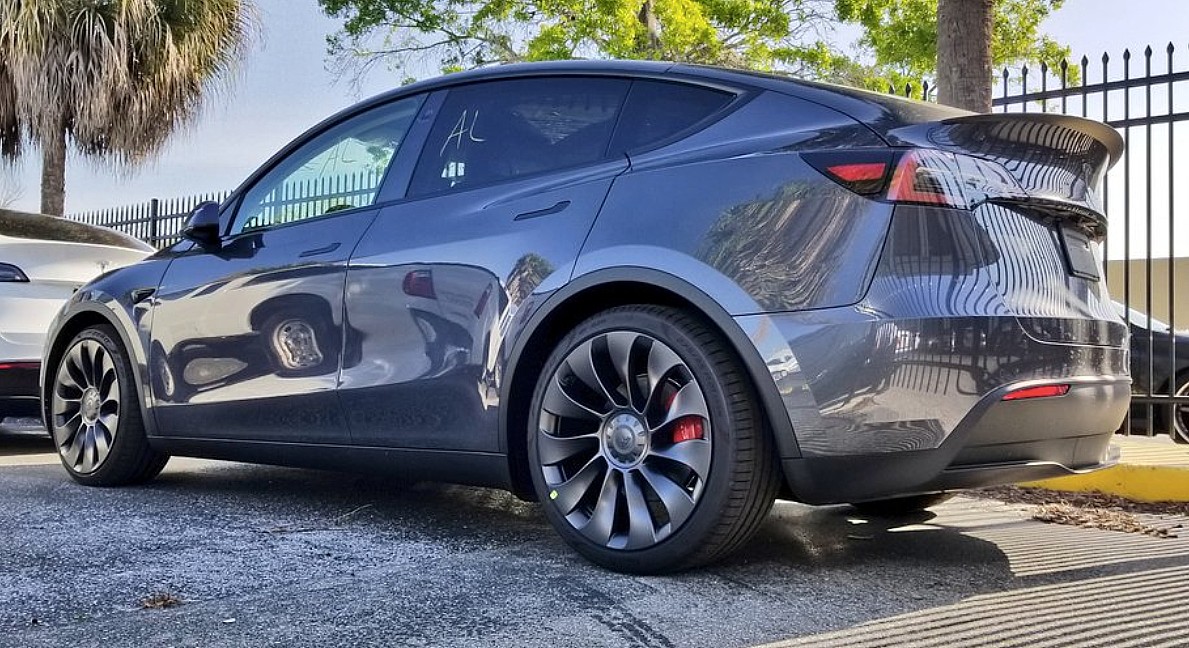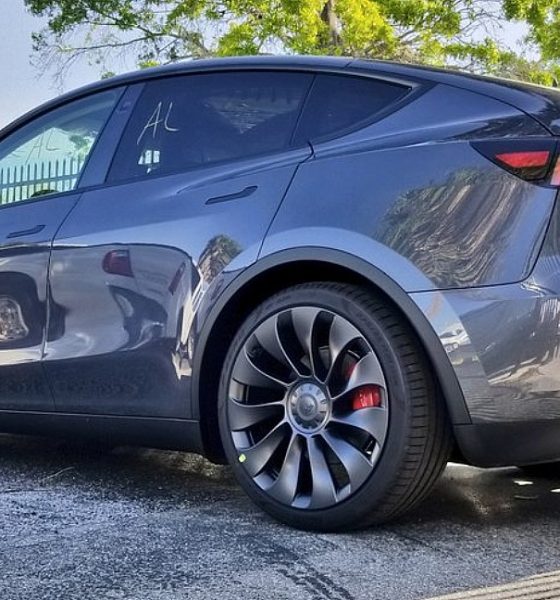

News
Tesla Model Y is what happens when the Model 3 taps into its full potential
With Tesla Model Y deliveries now starting, the first in-depth reviews of the all-electric crossover have surfaced. These reviews and walkthroughs of the Model Y show that the vehicle is very much like the Model 3, if the all-electric sedan’s utility and practicality were raised to 11. A lot of this has to do with the Y’s driving modes, its storage space, and its spacious interior.
The Model 3 is not a small car by any means, but it is a midsize sedan. It’s a stunning car that beats premium rivals like the BMW 3-Series in terms of performance, but it does lack some points in terms of utility compared to say, Tesla’s flagship sedan, the Model S. The Model 3 has 15 cubic feet of cargo space, which is great for its class, but it is far smaller than the 66 cubic feet of cargo space in a 5-seater Model Y.
Tesla’s vehicles are already optimized for space, but with the added height and size of the Model Y, owners can enjoy a cabin that’s could very well feel closer in proportion to the Model X SUV than its Model 3 sedan sibling. This is particularly evident in the second-row seats, as the all-electric crossover’s tall stance offers ample headroom even for tall passengers. It remains to be seen if the Y’s third-row seats could be usable for adult passengers, but its second-row seats provide a lot of headroom and legroom.
The Model Y even has a particularly unique feature that is not present in the Model 3, or any of Tesla’s current vehicles for that matter. A look at the all-electric crossover’s menus shows that the vehicle has a dedicated “Off-Road Assist” feature. The function allows drivers to gain more control of the vehicle, which would be invaluable when driving on forest trails. Among the Model Y’s features, from its combined cargo area that can fit seven carry-on suitcases to its comfortable cabin with USB-C ports, it is Off-Road Assist that is pretty much the most surprising.
Expectations for the Model Y, after all, have been quite conservative. While Elon Musk has mentioned that the Model Y will likely outsell the Model 3, Model S, and Model X combined, Tesla has been pretty restrained in terms of marketing its crossover. This is classic Tesla (the months of Model 3 anti-selling come to mind), but now that deliveries have begun, it is starting to become evident that the Model Y is designed to become an even bigger disruptor than its sedan sibling. As it turns out, the Model Y is really a vehicle that is designed to take on the best of the premium crossover market, even if it’s off paved roads.
It is fitting that Tesla is producing the Model Y at this point in the company’s history. Tesla has learned valuable lessons with each vehicle that it released so far. One could then argue that the company had to learn the knowledge it gained with the Model 3’s production challenges before it even attempted to ramp the Model Y. Tesla is a much different automaker today, and this is one of the key reasons why now is the perfect time for Tesla to enter the crossover segment. In a way, the Model Y is definitely a lot like the Model 3, only this time, it is disrupting a segment that’s far larger in the auto industry.
Following is an in-depth review of the Tesla Model Y, courtesy of owner-enthusiast Tesla Raj.

Elon Musk
Elon Musk’s X will start using a Tesla-like software update strategy
The initiative seems designed to accelerate updates to the social media platform, while maintaining maximum transparency.

Elon Musk’s social media platform X will adopt a Tesla-esque approach to software updates for its algorithm.
The initiative seems designed to accelerate updates to the social media platform, while maintaining maximum transparency.
X’s updates to its updates
As per Musk in a post on X, the social media company will be making a new algorithm to determine what organic and advertising posts are recommended to users. These updates would then be repeated every four weeks.
“We will make the new 𝕏 algorithm, including all code used to determine what organic and advertising posts are recommended to users, open source in 7 days. This will be repeated every 4 weeks, with comprehensive developer notes, to help you understand what changed,” Musk wrote in his post.
The initiative somewhat mirrors Tesla’s over-the-air update model, where vehicle software is regularly refined and pushed to users with detailed release notes. This should allow users to better understand the details of X’s every update and foster a healthy feedback loop for the social media platform.
xAI and X
X, formerly Twitter, has been acquired by Elon Musk’s artificial intelligence startup, xAI last year. Since then, xAI has seen a rapid rise in valuation. Following the company’s the company’s upsized $20 billion Series E funding round, estimates now suggest that xAI is worth tens about $230 to $235 billion. That’s several times larger than Tesla when Elon Musk received his controversial 2018 CEO Performance Award.
As per xAI, the Series E funding round attracted a diverse group of investors, including Valor Equity Partners, Stepstone Group, Fidelity Management & Research Company, Qatar Investment Authority, MGX, and Baron Capital Group, among others. Strategic partners NVIDIA and Cisco Investments also continued support for building the world’s largest GPU clusters.
News
Tesla FSD Supervised wins MotorTrend’s Best Driver Assistance Award
The decision marks a notable reversal for the publication from prior years, with judges citing major real-world improvements that pushed Tesla’s latest FSD software ahead of every competing ADAS system.

Tesla’s Full Self-Driving (Supervised) system has been named the best driver-assistance technology on the market, earning top honors at the 2026 MotorTrend Best Tech Awards.
The decision marks a notable reversal for the publication from prior years, with judges citing major real-world improvements that pushed Tesla’s latest FSD software ahead of every competing ADAS system. And it wasn’t even close.
MotorTrend reverses course
MotorTrend awarded Tesla FSD (Supervised) its 2026 Best Tech Driver Assistance title after extensive testing of the latest v14 software. The publication acknowledged that it had previously criticized earlier versions of FSD for erratic behavior and near-miss incidents, ultimately favoring rivals such as GM’s Super Cruise in earlier evaluations.
According to MotorTrend, the newest iteration of FSD resolved many of those shortcomings. Testers said v14 showed far smoother behavior in complex urban scenarios, including unprotected left turns, traffic circles, emergency vehicles, and dense city streets. While the system still requires constant driver supervision, judges concluded that no other advanced driver-assistance system currently matches its breadth of capability.
Unlike rival systems that rely on combinations of cameras, radar, lidar, and mapped highways, Tesla’s FSD operates using a camera-only approach and is capable of driving on city streets, rural roads, and freeways. MotorTrend stated that pure utility, the ability to handle nearly all road types, ultimately separated FSD from competitors like Ford BlueCruise, GM Super Cruise, and BMW’s Highway Assistant.
High cost and high capability
MotorTrend also addressed FSD’s pricing, which remains significantly higher than rival systems. Tesla currently charges $8,000 for a one-time purchase or $99 per month for a subscription, compared with far lower upfront and subscription costs from other automakers. The publication noted that the premium is justified given FSD’s unmatched scope and continuous software evolution.
Safety remained a central focus of the evaluation. While testers reported collision-free operation over thousands of miles, they noted ongoing concerns around FSD’s configurable driving modes, including options that allow aggressive driving and speeds beyond posted limits. MotorTrend emphasized that, like all Level 2 systems, FSD still depends on a fully attentive human driver at all times.
Despite those caveats, the publication concluded that Tesla’s rapid software progress fundamentally reshaped the competitive landscape. For drivers seeking the most capable hands-on driver-assistance system available today, MotorTrend concluded Tesla FSD (Supervised) now stands alone at the top.
News
Elon Musk’s Grokipedia surges to 5.6M articles, almost 79% of English Wikipedia
The explosive growth marks a major milestone for the AI-powered online encyclopedia, which was launched by Elon Musk’s xAI just months ago.

Elon Musk’s Grokipedia has grown to an impressive 5,615,201 articles as of today, closing in on 79% of the English Wikipedia’s current total of 7,119,376 articles.
The explosive growth marks a major milestone for the AI-powered online encyclopedia, which was launched by Elon Musk’s xAI just months ago. Needless to say, it would only be a matter of time before Grokipedia exceeds English Wikipedia in sheer volume.
Grokipedia’s rapid growth
xAI’s vision for Grokipedia emphasizes neutrality, while Grok’s reasoning capabilities allow for fast drafting and fact-checking. When Elon Musk announced the initiative in late September 2025, he noted that Grokipedia would be an improvement to Wikipedia because it would be designed to avoid bias.
At the time, Musk noted that Grokipedia “is a necessary step towards the xAI goal of understanding the Universe.”
Grokipedia was launched in late October, and while xAI was careful to list it only as Version 0.1 at the time, the online encyclopedia immediately earned praise. Wikipedia co-founder Larry Sanger highlighted the project’s innovative approach, noting how it leverages AI to fill knowledge gaps and enable rapid updates. Netizens also observed how Grokipedia tends to present articles in a more objective manner compared to Wikipedia, which is edited by humans.
Elon Musk’s ambitious plans
With 5,615,201 total articles, Grokipedia has now grown to almost 79% of English Wikipedia’s article base. This is incredibly quick, though Grokipedia remains text-only for now. xAI, for its part, has now updated the online encyclopedia’s iteration to v0.2.
Elon Musk has shared bold ideas for Grokipedia, including sending a record of the entire knowledge base to space as part of xAI’s mission to preserve and expand human understanding. At some point, Musk stated that Grokipedia will be renamed to Encyclopedia Galactica, and it will be sent to the cosmos.
“When Grokipedia is good enough (long way to go), we will change the name to Encyclopedia Galactica. It will be an open source distillation of all knowledge, including audio, images and video. Join xAI to help build the sci-fi version of the Library of Alexandria!” Musk wrote, adding in a later post that “Copies will be etched in stone and sent to the Moon, Mars and beyond. This time, it will not be lost.”








